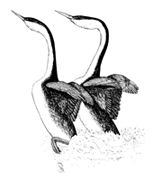Papers in the Biological Sciences

Diving Birds of North America by Paul A. Johnsgard
Date of this Version
April 1987
Document Type
Book Chapter
Abstract
The geographic distributions of the loons, auks, and grebes are primarily reflections of the evolutionary histories of each of the groups, past climatic and geologic phenomena, and present-day climatic and ecological conditions. Thus all the loons and auks are Northern Hemisphere birds, which presumably have never been able to bridge the tropical barrier into the Southern Hemisphere, where seemingly suitable breeding habitat might exist in, for example, southern South America and Tierra del Fuego. Indeed, the breeding distribution of the Northern American loons is distinctly arctic oriented, with the greatest species density north of the boundaries of arctic tundra in Canada and Alaska and no breeding occurring south of the limits of continental glaciation.
On the other hand, the breeding distributions of the grebes are distinctly more southerly; indeed, more than half the species of grebes are equatorial or Southern Hemisphere in occurrence. In North America the breeding distributions of grebes are more closely related to topography and ecology than to climate, with the greatest species density occurring in the grasslands of southern Canada and the adjacent northern United States, in a general east-west band more or less approximating the distribution of the "prairie pothole region" of Pleistocene glacial till that until recently was primarily grassland covered, but with abundant potholes and marshes. In such areas all but one of the North American grebes can sometimes be found breeding in a single marsh, which suggests that there may be substantial selective pressures for ecological segregation of foraging niches and other aspects of niche adaptation as well. Some of these questions of niche segregation will be dealt with in chapter 4. Finally, the breeding distributions of the North American auks are, like those of the loons, distinctly arctic in orientation. Species densities reach a maximum in the Aleutian Islands, where as many as twelve to fourteen species might be found breeding. This is substantially greater than on the eastern coast of North America, where there is a maximum density of five sympatric breeding species. Udvardy (1979) analyzed the distribution of the Pacific alcids in considerable detail; he correlated the present-day distribution of these species with dispersal waves extending back to mid-Eocene times and reflecting a Pacific basin origin of the family centering on the Bering Sea. Udvardy imagined a series of five dispersal waves between the Pacific and Atlantic areas, reflecting the five interglacial periods when the Bering Strait was open. During at least the latest glacial period the Sea of Okhotsk was perhaps the most important and also the northernmost refuge, and many of the Pacific Ocean alcids still are essentially limited to glacial refuge areas. The present-day subtropical ranges of various southern endemics such as Craveri and Xantus murrelets were considered to be a result of their being Tertiary relicts, whose ranges and populations farther north were eliminated by climatic changes.


Comments
From Diving Birds of North America (1987) by Paul A. Johnsgard. Copyright © 2007 Paul Johnsgard. Cite this work as: Paul Johnsgard, Diving Birds of North America (Lincoln, Nebraska: University of Nebraska Press, 1987; University of Nebraska–Lincoln Libraries, 2008 [ebook edition]).